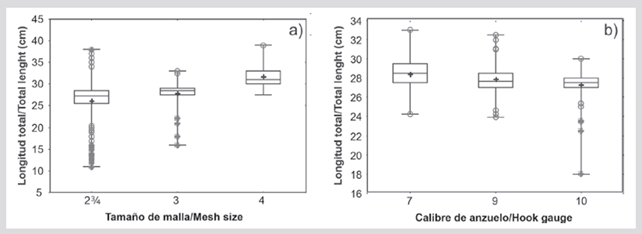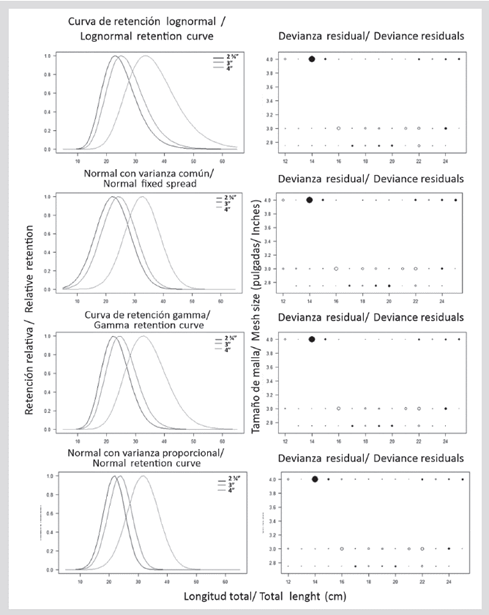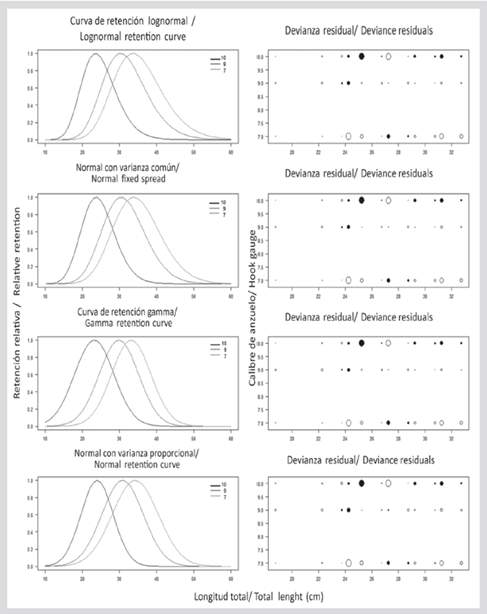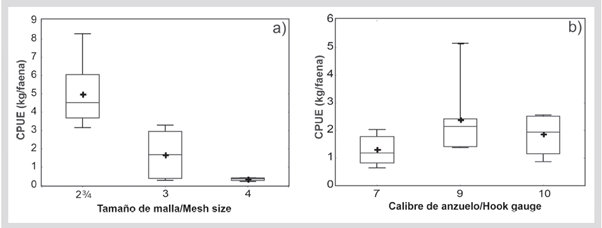INTRODUCTION
Fishing has long been an important economic activity in many parts of the world, becoming the principal ways of generating income in coastal and riverine communities (McGoodwin, 1990) and therefore contributes to the generation of employment that can be than 203 million full-time equivalent jobs (Teh and Sumaila, 2013). However, the activity is currently being less profitable due to the decrease in abundances (García et al., 2007); stimulating the use of less selective fishing gear and methods with commercially exploited species and of course with the ecosystem, resulting from the extraction of fishing resources above their natural renewal rates.
This decrease in abundances drives a constant increase in the size of the fishing gear, resulting in greater fishing power, which is also combined with the reduction of the escape capacity of size organisms in the early stages of their biological development (McClanahan and Mangi, 2004; Altamar et al., 2015), as is the capture before its first spawning, a key moment for the constant renewal of exploited stocks. The impact on size structures is a direct effect of both industrial and artisanal fisheries, the latter being especially detrimental to the ecosystem when good practices are not carried out; its use being common in coastal areas and/or areas of high biological diversity where juveniles fulfill part of their life cycle in breeding areas and are more abundant.
Reducing the possibility of escape of sexually immature organisms due to the low selectivity of the fishing gear requires management strategies (Quentin et al., 2010), which are thought to improve the selection of the size and the species captured. It is then a matter of contributing to the sustainability of the fishery by avoiding the capture of juvenile organisms, which are more abundant in relation to the adults of that population, and all this should happen without affecting the economic profitability. This problem acquires special importance in marine protected areas (MPAs) and their adjacent zones, where historically fisheries have developed around the capture of several species, with the use of not very selective fishing gear and under an exploitation regime lacking in order. Given the ecological importance of MPAs for the structure and function of aquatic ecosystems, adjacent fishing grounds must consider the possibility of establishing some type of technological measure that increases the selectivity of fishing gear.
Due to its presence in most of the landings of different fishing gear, the black-faced blue runner (Caranx crysos) is an example of this problem (Manjarrés-Martínez et al., 2010). In this sense, its presence in the Tayrona MPA would act as a spillover effect to areas around the park (Martínez-Viloria et al., 2014). This species is distributed in tropical and subtropical coastal areas of America (Cervigón, 1993); on the Caribbean coast of Colombia, particularly in the areas adjacent to the Tayrona National Natural Park (TNNP), it is an important resource both for its economic value and for its abundance (Manjarrés-Martínez et al., 2010), to the point that various fishing gear they capture it, making the need to implement management measures urgent. Despite the above, within the possible strategies, the control of its capture through changes in the selectivity of the gears is a measure that little has been considered in Colombia, and with all certainty, this is due to the lack of technical information.
The proposed study considers two capture technologies based on the retained sizes. On the one hand, the gillnets maximize them in a narrow range of sizes, and decrease their efficiency of capture above or below it and, on the other hand, the use of hooks in hand lines whose selectivity is given by the size of the fish’s mouth and the type of bait, since it must be able to swallow the prey while the bait is an attractive device (Lagler et al., 1990; Tesfaye et al., 2016). To fill this information gap, selectivity parameters have been estimated and control measures predicted for two fishing gears (fixed gillnets and hand lines) used in the artisanal capture of C. crysos.
STUDY AREA
The fishing operations with gillnets and hand lines were carried out within the Tayrona ecoregion, particularly in adjacent TNNP areas; a protected area located on the coasts of the Caribbean Sea of Colombia (Figure 1). The study area covered the coastal strip from Punta Gloria to the mouth of the Piedras River, excluding the TNNP where fishing is prohibited, and advancing a more to the northeast to the Buritaca River. The marine strip of this ecoregion has a narrow continental shelf with depths of more than 200 m a short distance from the coast, clear waters, rocky and sandy bottoms, in the shallow part, and muddy in the deep; Bathymetrically, the operations were carried out up to 30 m with a gillnet and up to 100 m with a hand line (Invemar, 2000).
MATERIALS AND METHODS
The success of gillnet or handline selectivity studies is highly dependent on obtaining sufficient catches, in terms of several fish, so that the selective effect of different hooks or gauges is noticeable. Although these factors have been studied in detail, there is no way to estimate the minimum number of sets required, as this depends on the success or efficiency of the trapping process.
Between November 2018 and February 2019, 21 experimental fishing operations were carried out, with a duration that ranged between 9 and 11 h of effective fishing time for the gillnet and 3 to 5 h for the hand lines, a similar period used by fishermen in the area. The mesh sizes and hook gauges evaluated to determine the selectivity parameters were selected based on two aspects, the first length or length at sexual maturity (Lm) of the C. crysos species and the second based on the dimensions and construction aspects typical of the artisanal fishery in the study area (Gómez et al., 2004; Altamar and Zúñiga, 2015, Marrugo et al., 2017).
An experimental net was constructed with three bodies, each of them with mesh sizes 7.0, 7.6, and 10.2 cm (2–, 3, and 4 inches), constructed with monofilament polyamide (PA). Each body was 117 m long in its upper rope and an approximate height of 11 m with a coefficient of reinforcement 0.65; these bodies were tied from one end to the other in a single band and their position was changed randomly at each slaughter to achieve a similar probability of capture (Fabi et al., 2002) and thus reduce the possible effect of the position on the fish catch yields. Likewise, the hand lines were built with 70 lbf resistance monofilament PA, using three 1.3 m downspouts from which J type hooks with 7, 9, and 10 gauges were knotted, with 0.3 m spacing between downspouts and a ballast of 0.3 kg of lead. At each task the hooks were placed randomly, leaving all the configurations exposed for fishing at the same time. In the tasks carried out with the hand line, the machuelo (Opisthonema oglinum) of the same size and organoleptic quality was used as bait.
In all fishing sets made, the total catch was quantified in number and weight. The captured specimens were separated on board in boxes or containers according to the body (mesh size) in which the fish were retained and in the case of the hand lines according to the size of the hook, later on-land, it was carried out with the corresponding biometry (total length and weight). To assess the efficiency of the fishing gear configurations, the relative abundances or Catch per Unit of Effort (CPUE) in terms of kg × faena-1 were compared, for which the Kruskal Wallis test was used by using the software STATISTICA v13.
Selectivity was evaluated by determining the selectivity curves for the three mesh sizes and the three hook gauges, for which the selectivity parameters were estimated from the SELECT method (Millar, 1992). The selectivity curves were fitted using the package “gillnet functions” in the R statistical software (Millar, 2003, 2010; R Core Team, 2019). The SELECT method assumes that the number of fish of length l caught with hook size or mesh size j has a Poisson n lj distribution, and is defined by the following equation:
Where,
p j is the relative fishing intensity,
λ l is the abundance of fish size class l, and
r j (l) is the probability of retention of fish l on the hook or mesh size j.
The relative fishing intensity of a hook is a combined measure of fishing effort and fishing power (Millar, 1992). This method uses a Generalized Linear Model (GLM) described in Millar (1992) of the Poisson family and with the Log link function, which is specifically applicable in gillnets and hooks as described in Millar and Holst (1997) and Millar and Frye (1999). The SELECT method estimates the retention probabilities using four unimodal models (Localization Normal, Scale Normal, Gamma, and Log-normal), which apply the maximum probabilities to estimate the selectivity parameters. The deviation of the model (goodness of fit statistics of the probability ratio) was calculated and used as a criterion to choose the model that best fit for the species considered. The equations of the models used in the SELECT method are presented below (Table 1).
RESULTS
In 42 fishing sets a total of 1039 specimens of C. crysos were caught, of which 588 came from gillnets and 451 from hand lines. The median (mean ± SD) of the total length captured with mesh sizes of 7.0, 7.6, and 10.2 cm were 27.40 (26.03 ± 5.14), 28.50 (27.84 ± 2.60), and 30.80 (31.66 ± 2.88) cm (Figure 2A), while sizes n.° 7, 9 and 10 reached medians (means ± SD) of 28.90 (28.37 ± 1.82), 26.90 (27.86 ± 1.48), and 28.30 (27.27 ± 1.56) cm (Figure 2B). In general, the mesh size and the largest hook size of those evaluated caught the largest individuals on average. However, the smaller sizes exhibited a wide range of sizes (Figure 2).

Figure 2 Box-and-whisker graph comparing the medians of the total blue runner length for the evaluated configurations. A) Mesh sizes in the gillnet. B) Hook gauges in the hand line.
The results of the SELECT method adjusted to C. crysos determined the selectivity parameters of each model evaluated (Table 2). The estimated modal lengths corresponding to the size with the maximum probability of capture and the dispersion value obtained from the best fit model for the gillnet and the hand line are shown in Table 3. The selectivity curves adjusted for the gillnet Gill and hand lines, for each model, are shown in Figures 3 and 4. Of the four different selectivity models, the log-normal provided the best fit (lowest devolution value), indicating that this model can best describe gillnet and hand line catches for this species. Also, Figures 3 and 4 show residual deviation graphs from the estimated selectivity curves.
Table 2 Selectivity parameters estimated from the four models evaluated for gillnet and hand line that catch Caranx crysos.

Table 3 Caranx crysos modal length for all three mesh sizes (7.0, 7.6, and 10.2 cm) and three hook gauges (n.° 10, 9, and 7).


Figure 3 Selectivity curves for gillnets and residue devolution for each of the Models evaluated at Caranx crysos in the Santa Marta region.

Figure 4 Selectivity curves of hand lines and deviation of the residues for each of the models evaluated at Caranx crysos in the Santa Marta region.
In terms of CPUE (kg × faena-1), the most efficient configuration was the 7 cm cloth with 4.9 kg × faena-1, followed by the 7.6 and 10.2 cm cloths with 1.7 and 0.4 kg × faena-1, respectively (Figure 5A). Comparison of the CPUE medians presented statistical differences (p < 0.05) between all the mesh sizes evaluated. On the other hand, the largest hook (gauge n.° 7) of those evaluated turned out to be the least efficient, obtaining the lowest CPUE (1.4 kg × faena-1). Hooks n.° 9 and 10 gauge did not show statistical differences among themselves (p > 0.05) with 2.2 and 1.9 kg × faena-1, respectively (Figure 5B).
DISCUSSION
All the estimated modal lengths for each curve (gillnet and hand line) were less than 35 cm, which corresponds to the mature size of the blue runner (Altamar et al., 2015), which indicates that the selection capacity of the gillnet and hand line fishing gear, that catches blue runner should be reviewed in terms of the mesh sizes and hooks evaluated. Gillnet fisheries typically use mesh sizes of 6.35 and 7.62 cm, and this study found that 10.2 cm is the mesh size that most closely approximates the size at maturity. However, the possible application of a measure based on the regulation of the art would be affected by the fact that the mesh size that should be implemented (10.2 cm) was the one that obtained the lowest CPUE (kg × faena-1).
In studies carried out with gillnets for this species, Marrugo et al. (2016) estimated an optimal mesh size of 8.4 cm estimated from the L50 which is commercially equivalent to 5 inches, and 9.4 cm for the L90-100, which is commercially equivalent to 4 inches. It is important to note that more than 80 % of the nets use mesh sizes smaller than 8.9 cm and with them, they capture between 61 % (Altamar et al., 2015) and 69 % (AUNAP-Unimagdalena, 2013) of individuals below the size of maturity.
A recommended management measure to initiate a process to replace fishing gear, in this case, gillnets, would be to test with fishermen a set of 8.9 cm or larger cloths to reduce the capture of immature individuals and make little progress gradually toward incorporating 10.2 cm cloths. In any case, any regulation derived from this study must be agreed upon within the framework of a participatory management system with the actors involved in the process, in such a way that they can evaluate in a participatory way the eventual bio-ecological and economic benefits of a measure of this kind. Finally, management measures aimed at controlling the use of some hook gauges would be very difficult in practice due to the availability of using other gauges of hooks and the ease of changing them at the time of work. In both cases, perhaps it would be more useful to carry out educational campaigns that motivate fishermen, including their family nucleus, and consumers to carry out and promote (payments of a fair price) for the realization of good fishing practices, mainly those that recommend constructive parameters that improve the selection of capture sizes.
According to the selectivity curves estimated for the blue runner, both in gillnets and hooks, the model with the best fit was log-normal. In the case of nets, the modal length closest to the maturity size was presented in the 10.2 cm curve. However, nets with this mesh size are considered in some sites in the study area as seasonal or optional fishing gear, that is, at some times of the year, larger individuals such as horse mackerel are used to catch but the rest of the year they use it less due to its inefficiency for more frequent species such as the blue runner. In the same way, proposing only the optimal mesh size for fishing a resource is not enough to promote sustainable fishing, it is necessary to take into account other technological modifications on the design of the gillnet, such as the coefficient of setting and the working position of the net that ultimately determine its efficiency, that is, a net could meet the recommended mesh size standard, but using a setting coefficient below 0.5 would contribute to increasing the catch per entanglement of individuals below the maturity size.
On the other hand, in the case of the evaluated hook sizes, all the estimated modal lengths in the selection curves are less than the maturity size. Therefore, it is important to determine areas and/or times where sustainable catches of the fish can be made. Blue runner resource for both hooks and gillnets, and that in other fisheries, such as striped snapper (Lutjanus synagris), they have been the key to defining the impact of fishing gear on mortality and average catch sizes (Manjarrés et al., 2004).
Finally, based on these inputs, it is important that the managers of the fishing resource in the Tayrona NNP and in the adjacent areas, where it is exercised by the National Aquaculture and Fisheries Authority (AUNAP), should articulate to establish complementary management measures that promote developing responsible fishing activities for the blue runner (Caranx crysos), being that it is one of the main objects of catch. Also, based on Baranov’s principle of geometric similarity, which proposes the proportionality between the perimeter of a mesh and the perimeter circumference of the fish, this type of measure would have the advantages of the “umbrella species” effect, since it ends up protecting to other species of great commercial importance that have a smaller maximum perimeter circumference at the maturity size of the blue runner (e.g. carite, Scomberomorus brasiliensis).
CONCLUSIONS
In the adjacent areas of Tayrona National Natural Park, the best-fit Model obtained for the Caranx crysos catches, both for gillnets and hand lines, was log-normal. The modal lengths calculated were 23.00, 25.09, and 33.46 cm for mesh sizes 7, 7.6, and 10.2 cm, while 23.72, 30,49, and 33,88 cm for hooks n.° 7, 9, and 10, respectively. In either case, nets and lines, are very important to consider consensus processes with artisanal fishermen to take advantage of their traditional ecological knowledge and ensure the success of any management measure that is implemented.
Finally, even though the fishing operations were carried out in fishing areas adjacent to the Tayrona NNP, all the estimated modal sizes are below the maturity size of the blue runner, for which the managers of the resource and the AMP must consider the application of management measures based on the ordering of fishing gear.




![Diet and trophic niche breadth of the neotropical cormorant [Nannopterum brasilianus (Gmelin, 1789)] in the Flora and Fauna Sanctuary Ciénaga Grande de Santa Marta, Caribbean Colombia](/img/en/prev.gif)






 text in
text in 







